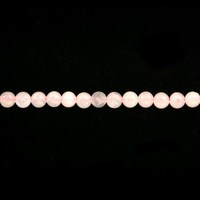Beader’s dictionary
A
AGATE (See products)
Agate is gemstone of the quartz family. It is a kind of ribboned calcedony with concentric layers. The agate is a very shiny stone when polished and is available in a number of colors and patterns: yellow agate, moss agate, etc. Up to the XIXth century, it was widely used for cameos.
Agates can be found in South America, in the United States, Australia, India, China and Africa.
A little bit of history: it is believed that the stone got its name out of the Achates river, where many of them were found in Ancient Rome. It is also believed that its name could derive from an Arabic word that refers to a new-born’s hair.
C
CAMEO
A cameo is a low-relief glyptic art carving technique (art of stone carving in relief or intaglio). This technique is used on materials made of layers of colors. The sculptor must carve while taking into account the different layers of color and depth to play with so that the various colors are positioned in the right places. Cameos representations are often found as a bust of an influential political, cultural or religious character. Hence, the term "cameo" also refers to the resulting object of the carving.
The most popular stratified materials that are used are onyx, banded agate, sardonyx, carnelian-onyx, chalcedony, the shell from layered seashells and glass. Sometimes, the color differences are exacerbated by dye. White strata, as they are very compact, do not stain, unlike the softer strata.
Stone cameos are very expensive, thus they were replicated in materials such as shells, glass, coral or lava. Today, we also find imitations made of various other materials.
A little bit of history: The cameo was very fashionable in Classical Antiquity then forgotten and resurfaced during Renaissance as Napoleon was an avid cameo collector and he instituted a special school to promote the engraving of stones.
CARNELIAN (See products)
Carnelian is a gemstone of the chalcedony family. It can be translucent to opaque and its color ranges from reddish brown to reddish orange. Its color is due to the presence of iron oxides and is similar to the pulp of the dogwood’s fruit (a reddish type of berry). It is often mistaken with the dyed agate. This gemstone is naturally prevalent in India, Brazil and Uruguay.
CHALCEDONY (See products)
The term chalcedony designates all varieties of quartz and microcrystalline and cryptocrystalline. It includes agate, carnelian, jasper, onyx and other varieties of quartz. However, the term chalcedony is often used to denote the common chalcedony sensu stricto. It can have a milky appearance and be transparent, and bluish white-grey.
It can be dyed as it is porous. It can be found in Brazil, the United States, India, Madagascar, Namibia, Sri Lanka and Zimbabwe.
A little bit of history: The name comes from the Greek "Karchêdôn", an ancient transit city on the Bosphorus (Istanbul strait). Roman and Egyptian used it in cameos, seals and amulets. Today, it is often found in the form of a cabochon, as beads, rings or artifacts. In the Neolithic period, chalcedony was used to make tools.
G
GURU BEAD (See products)
Guru beads are rounds beads that have three holes when they are looked at from the outside. If we could see through the bead, the bead’s hole would be shaped like a “T”. These beads are always paired with a second conically shaped bead. They are used to join string ends. Both string extremities are threaded in the holes above the “T” and are exited together in the hole bellow the “T”. Following which, the conic bead is strung and the strings are tied together. Their size vary, however they more often than not measure about 8mm. They are generally made with semiprecious stones such as agates, cornelian and onyx but can also be made of wood and glass. The guru beads are often used to finish bracelets or mala bead necklaces (Buddhist or Hindu rosaries). This part of the rosary would represent Buddha or the master, thus the name guru.
J
JASPER (See products)
Jaspers are precious stones that are part of the quartz family. Jaspers are opaque stones that are available in many colors and are usually freckled, striped or multicolored. Monochromatic jaspers are extremely rare. Jaspers are often found as cabochons, beads or used to create art pieces or mosaics.
There are various types of Jaspers; the picture jasper which has a sand color veined with brownish-black, the mookaite which is found in shades of pink to dark red, the leopard skin jasper which is spotted, the orbicular jasper which is sprinkled with circular spots that range from beige to black, the dalmatian jasper that is beige with black spots, the jaspagate (also agate jasper) which is yellow, brown or green mixed with agate, the stratified ribboned jasper that comes in various colors, the sanguine jasper or heliotrope which is dark green with red accents. The main deposits are found in Australia, Brazil, Canada, Egypt, in the United-States, in India, Kazakhstan, madagascar, Russia and Uruguay.
Q
QUARTZ
The term "quartz" refers to a family of minerals within the group of silicates. Quartz composes 12% of the lithosphere (outermost shell) and is the most common mineral. Quartzs are divided into different categories, among them the macrocrystalline quartz (amethyst, citrine, rock crystal, quartz smoke, rose quartz, blue quartz, quartz cat-eye, iron-eye, falcon-eye and tiger-eye ) and microcrystalline quartz (chalcedony, carnelian, onyx, agate, chrysoprase, jasper and petrified wood).
Z
ZODIAC STONES
During Antiquity as well as Middle-Ages, it was believed that the formation of gems was influenced by constellations, some gems were as bright as stars. They were thought to be the mirrors of the cosmos. Therefore each planet was associated with one or more gems that possess “magical” properties. These beliefs still circulate in todays modern society, even though there are no tangible proof to support them.
| Sign | Stones |
|---|---|
| ARIES | Carnelian, red jasper |
| TAURUS | Carnelian, pink quartz |
| GEMINI | Citrine, tiger's eye |
| CANCER | Chrysoprase, aventurine |
| LEO | Rock crystal, golden quartz |
| VIRGO | Citrine, yellow agate |
| LIBRA | Orange citrine, smoked quartz |
| SCORPIO | Blood red Carnelian |
| SAGITTARIUS | Sapphire, chalcedony |
| CAPRICORN | Onyx, rutilated quartz |
| AQUARIUS | Turquoise, falcon eye |
| PISCES | Amethyst, quartz amethyst |















